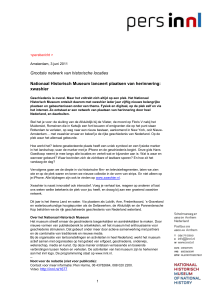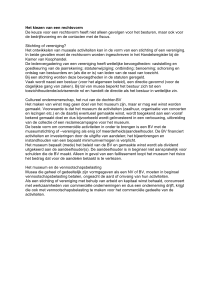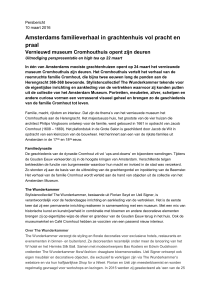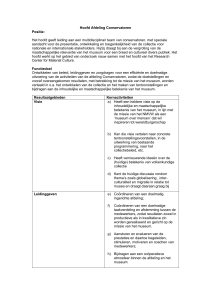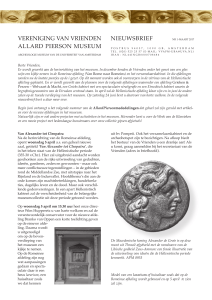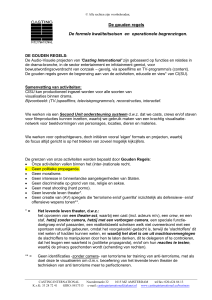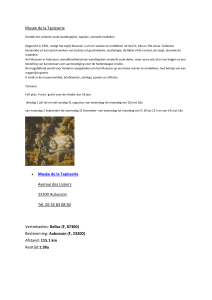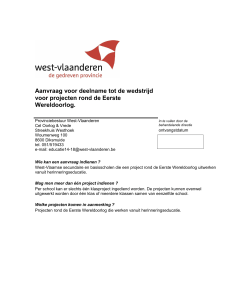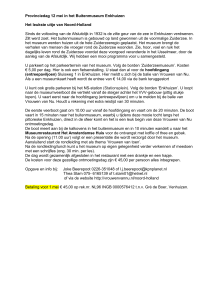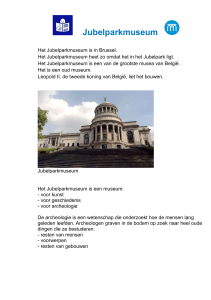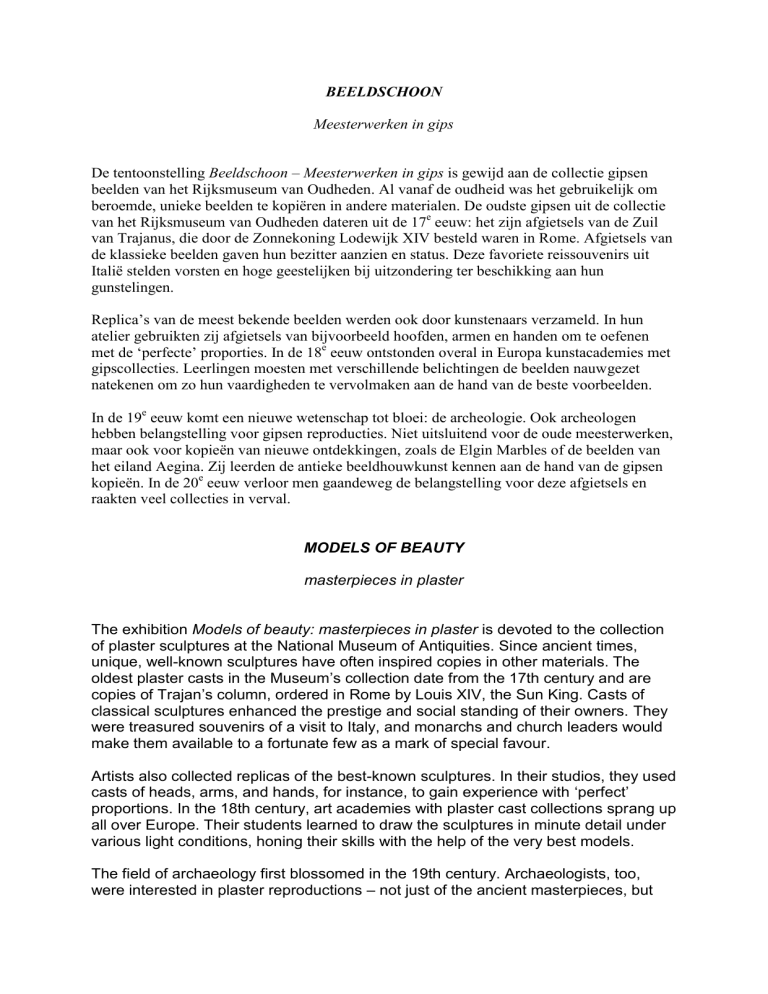
BEELDSCHOON
Meesterwerken in gips
De tentoonstelling Beeldschoon – Meesterwerken in gips is gewijd aan de collectie gipsen
beelden van het Rijksmuseum van Oudheden. Al vanaf de oudheid was het gebruikelijk om
beroemde, unieke beelden te kopiëren in andere materialen. De oudste gipsen uit de collectie
van het Rijksmuseum van Oudheden dateren uit de 17e eeuw: het zijn afgietsels van de Zuil
van Trajanus, die door de Zonnekoning Lodewijk XIV besteld waren in Rome. Afgietsels van
de klassieke beelden gaven hun bezitter aanzien en status. Deze favoriete reissouvenirs uit
Italië stelden vorsten en hoge geestelijken bij uitzondering ter beschikking aan hun
gunstelingen.
Replica’s van de meest bekende beelden werden ook door kunstenaars verzameld. In hun
atelier gebruikten zij afgietsels van bijvoorbeeld hoofden, armen en handen om te oefenen
met de ‘perfecte’ proporties. In de 18e eeuw ontstonden overal in Europa kunstacademies met
gipscollecties. Leerlingen moesten met verschillende belichtingen de beelden nauwgezet
natekenen om zo hun vaardigheden te vervolmaken aan de hand van de beste voorbeelden.
In de 19e eeuw komt een nieuwe wetenschap tot bloei: de archeologie. Ook archeologen
hebben belangstelling voor gipsen reproducties. Niet uitsluitend voor de oude meesterwerken,
maar ook voor kopieën van nieuwe ontdekkingen, zoals de Elgin Marbles of de beelden van
het eiland Aegina. Zij leerden de antieke beeldhouwkunst kennen aan de hand van de gipsen
kopieën. In de 20e eeuw verloor men gaandeweg de belangstelling voor deze afgietsels en
raakten veel collecties in verval.
MODELS OF BEAUTY
masterpieces in plaster
The exhibition Models of beauty: masterpieces in plaster is devoted to the collection
of plaster sculptures at the National Museum of Antiquities. Since ancient times,
unique, well-known sculptures have often inspired copies in other materials. The
oldest plaster casts in the Museum’s collection date from the 17th century and are
copies of Trajan’s column, ordered in Rome by Louis XIV, the Sun King. Casts of
classical sculptures enhanced the prestige and social standing of their owners. They
were treasured souvenirs of a visit to Italy, and monarchs and church leaders would
make them available to a fortunate few as a mark of special favour.
Artists also collected replicas of the best-known sculptures. In their studios, they used
casts of heads, arms, and hands, for instance, to gain experience with ‘perfect’
proportions. In the 18th century, art academies with plaster cast collections sprang up
all over Europe. Their students learned to draw the sculptures in minute detail under
various light conditions, honing their skills with the help of the very best models.
The field of archaeology first blossomed in the 19th century. Archaeologists, too,
were interested in plaster reproductions – not just of the ancient masterpieces, but
also of new discoveries, such as the Elgin Marbles and sculptures from the island of
Aegina. Through plaster casts, they learned about antique sculpture. In the 20th
century, interest in these casts waned, and many collections gradually deteriorated.
‘Apollo Belvedere’, marmer
1e eeuw n.Chr., Vaticaanse Musea, Rome.
Apollo Belvedere, marble
1st century AD, Vatican Museums, Rome.
Alle wegen leiden naar Rome
De enige weg voor ons om groot, of indien mogelijk onnavolgbaar te worden, is het navolgen
van de antieke kunst...
(Johann Joachim Winckelmann, kunsttheoreticus, 1717-1768)
In de 16e eeuw komt in Italië de kunst van de oudheid in het middelpunt van de belangstelling
te staan. De renaissance streeft naar het laten herleven van het mooiste uit de oudheid. Het
pauselijke Rome krijgt keizerlijke allure. Bij opgravingen in Rome worden antieke beelden
gevonden, die de kunst blijvend gaan beïnvloeden: bijvoorbeeld de Apollo Belvedere, de
Laocoöngroep en de Torso Belvedere.
Beeldhouwers zoals Michelangelo gaan werken in de stijl van de antieke voorbeelden.
Kunstenaars uit heel Europa reizen naar Rome om de klassieke meesterwerken te leren
kennen en tekeningen te maken. Hun reproducties van de meesterwerken vinden bij vele
belangstellenden aftrek.
Ook de Europese vorstenhuizen en adel beginnen collecties antieke kunst te verzamelen. Wie
echter de meesterwerken op ware grootte wil bezitten, moet replica’s bestellen, in brons of in
gips. Het wordt echter niet aan iedereen toegestaan om kopieën te laten maken. Een afgietsel
van een beroemd beeld duidt op invloed, geld en uitstekende connecties.
All roads lead to Rome
The only way for us to become great, or if possible inimitable, is to imitate ancient
art…
(Johann Joachim Winckelmann, art theorist, 1717-1768)
In 16th-century Italy, ancient art became the focus of attention. The Renaissance
breathed new life into the finest achievements of the antique world, and the papal city
of Rome took on an aura of imperial glamour. European art was profoundly
influenced by ancient sculptures discovered during excavations in Rome, such as the
Apollo Belvedere, the Laocoön Group, and the Belvedere Torso.
Sculptors such as Michelangelo began emulating the style of these ancient models.
Artists from all over Europe travelled to Rome to learn from the masterpieces of
classical art and to draw them. These drawings were in great demand.
Europe’s aristocrats and ruling families began to collect ancient art, but those who
wished to own the life-sized masterpieces had to order bronze or plaster replicas. Not
everyone was allowed to make copies, however. It took influence, money, and
excellent connections to obtain a cast of a famous sculpture.
Bronzen afgietsels, gemaakt door Primaticcio voor koning François I,
ca. 1540, Fontainebleau.
Bronze casts made by Primaticcio for King Francis I,
c. 1540, Fontainebleau.
Cultuurtoerisme: de grand tour
In navolging van de talloze kunstenaars die zich naar Italië begaven om de antieke
meesterwerken te leren kennen, gingen ook jongelieden van goeden huize naar Italië. Dit
gebeurde meestal na afsluiting van de studie, en voor het begin van hun officiële loopbaan.
Deze ‘grand tour’ leidde de reizigers naar de centra van de Italiaanse kunst: Venetië,
Florence, Rome en Napels.
Getuige de reisverslagen genoten de jongelieden van alle aspecten van het Italiaanse leven, en
namen zij graag souvenirs mee als herinnering aan deze leerzame en onbezorgde tijd. Favoriet
waren klassieke oudheden als vazen, munten of cameeën, afgietsels van beroemde beelden,
schilderijen en modellen van antieke architectuur.
Deze modellen werden door gespecialiseerde ambachtslieden ondermeer in kurk vervaardigd.
In dit materiaal konden zij uiterst verfijnde details weergeven. Goedkoop waren deze
schaalmodellen niet – hoe groter, hoe duurder. In voorname woningen en landhuizen stonden
de souvenirs trots opgesteld. Zij lieten zien hoe erudiet de eigenaar zich voelde.
Cultural tourism: the Grand Tour
Many young people of high birth followed in the footsteps of the artists, travelling to
Italy to study the masterpieces of the ancient world. They usually went after
completing their education and before beginning their official careers. This Grand
Tour took them to the centres of Italian art: Venice, Florence, Rome, and Naples.
Accounts of such tours tell us that the young people enjoyed every aspect of Italian
life and were eager to take home souvenirs of this edifying and carefree period.
Favourite mementos included classical vases, coins, and cameos, casts of famous
sculptures, paintings, and models of antique architecture.
These models were produced by specialized craftsmen, often in cork, a material that
allowed them to replicate the very finest details. These scale models were not cheap
– the larger they were, the higher the price. Such souvenirs were proudly displayed in
upper-class homes and country estates whose owners wanted to show off their
erudition.
Toeristen in een antiekzaak, anonieme tekening,
1798, Rome (privécollectie).
Tourists at an antique shop, anonymous drawing,
1798, Rome (private collection).
Modellenwerk
Een werkelijk mooi voorwerp geeft de beschouwer in de kortst mogelijke tijd een zo groot
mogelijk aantal emoties en ideeënassociaties...
(Frans Hemsterhuis, filosoof, 1721-1790)
Kunstenaars verzamelden waar zij konden afgietsels van klassieke beelden: handen, voeten,
torso’s en hoofden werden nauwkeurig geschetst om de ideale proporties in de vingers te
krijgen. Ook werden antieke hoofden aangekleed met attributen en gebruikt als model voor
anonieme portretten, de zogenaamde tronies.
De 16e- en 17e- eeuwse tekenscholen ontwikkelden zich in de 18e eeuw tot officiële
kunstacademies. Hier werd het tekenen naar gips een vast onderdeel van de opleiding. De
tekenklas moest zo nauwkeurig mogelijk houding, spierpartijen, emoties en schaduwen van de
‘ideale’ antieke beelden weergeven. Met kroonluchters en spiegels kon de schaduwwerking
steeds anders worden geregeld.
Er was een canon van klassieke beelden, die in geen enkele academie mocht ontbreken. Veel
tekenscholen organiseerden jaarlijkse wedstrijden voor de beste tekeningen naar gips. De
winnende tekeningen bleven eigendom van de academie. Zes van deze tekeningen van
klassieke beelden uit de Rijksakademie van Amsterdam zijn hier tentoongesteld.
All-star casts
A truly beautiful object evokes the largest possible number of emotions and mental
associations in the viewer in the shortest possible time.
(Frans Hemsterhuis, philosopher, 1721-1790)
Artists collected casts of classical sculptures wherever they could find them,
sketching their hands, feet, torsos and heads in painstaking detail until they had
mastered their ideal proportions. Antique heads adorned with attributes were also
used as models for anonymous portraits known as tronies.
The drawing schools of the 16th and 17th centuries became official art academies in
the 18th, and drawing from plaster casts was part of the standard curriculum. In
drawing classes, students were expected to reproduce the poses, musculature,
emotions, and shadows of these ‘ideal’ antique sculptures. Chandeliers and mirrors
were used to create new patterns of light and shade each time.
There was a canon of classical sculptures that every academy had to have. Many
drawing schools held annual competitions for the best drawings from plaster casts.
The winning drawings remained the property of the academy. Six such drawings from
the Rijksakademie van Beeldende Kunsten, the National Academy of Art, in
Amsterdam, are on display here.
‘Het schildersatelier’, schilderij van Michael Sweerts,
ca. 1650, Rijksmuseum Amsterdam.
The painter’s studio, painting by Michael Sweerts,
c. 1650, Rijksmuseum Amsterdam.
De Rijksakademie: oefening baart kunst
De Rijksakademie van Beeldende Kunsten is in 1870 opgericht door Koning Willem III. De
akademie is de opvolger van vroegere Amsterdamse instellingen voor de kunsten: de
Konstkamer (17e eeuw), de Stads Teekenacademie (18e eeuw) en de Koninklijke Academie
(19e eeuw). Bij de opleiding hoorde een intensieve training in het tekenen naar anatomische
modellen, gipsen en naaktmodellen. Elk jaar werden prijzen verleend voor de beste
tekeningen naar gips.
In het verleden waren kunstenaars als Toorop, Berlage, Breitner, Mondriaan, Constant, Appel
en vele anderen verbonden aan de Rijksakademie. Naar gips wordt er nu niet meer geschetst,
maar een herwaardering voor de artistieke kwaliteit van het menselijk lichaam tekent zich de
laatste jaren af.
The Rijksakademie: practice is the mother of art
The Rijksakademie or National Academy of Art was founded in 1870 by King William
III. It was the successor to earlier Amsterdam art institutions: the 17th-century
Konstkamer (Art Cabinet), the 18th-century Municipal Drawing Academy, and the
19th-century Royal Academy. Its programme of study included intensive training in
drawing from anatomical models, plaster casts, and nude models. Prizes were
awarded yearly for the best drawings from plaster casts.
Through the years, such renowned artists as Jan Toorop, H.P. Berlage, George
Hendrik Breitner, Piet Mondrian, Constant, Karl Appel, and many others were
affiliated with the National Academy. The practice of drawing from plaster casts was
abandoned, but recent years have seen a revival of appreciation for the artistic
quality of the human body.
De tekenklas voor dames (met bolhoed: professor C.L. Dake), foto,
ca. 1910, Rijksakademie van Beeldende Kunsten, Amsterdam.
The ladies’ drawing class (taught by the bowler-hatted Professor C.L. Dake), photo,
c. 1910, Rijksakademie van Beeldende Kunsten, Amsterdam.
De Leidse Tekenacademie: kunst naar het leven
Rond 1694 richtte Willem van Mieris de Leidse Tekenacademie op. In 1799 ging deze
academie over in het tekengenootschap Ars Aemula Naturae (‘Kunst is de rivaal van de
natuur’). Kunstlievenden uit de betere standen leerden hier te tekenen naar model en gips, en
te discussiëren over het wezen van de kunst. Vier keer per jaar vonden grote
kunstbeschouwingen plaats.
In 1812 werd David P.G. Humbert de Superville docent van Ars Aemula Naturae. Daarnaast
was hij directeur van het Leidse Prentenkabinet. Hij beheerde een grote gipscollectie, die hij
niet wilde delen met de archeoloog Reuvens. Zo ontstonden twee gipscollecties in Leiden: één
kunsthistorisch en één archeologisch van aard. Beide collecties zijn opgegaan in de
verzameling van het Rijksmuseum van Oudheden.
Beroemde docenten bij Ars Aemula Naturae waren G.H. Breitner en Kees Verweij. Het
bekendste lid van de vereniging was Jan Wolkers.
The Leidse Tekenacademie: art imitating life
Around 1694, Willem van Mieris founded the Leidse Tekenacademie (Leiden
Academy of Drawing). In 1799 this academy became a drawing society called Ars
Aemula Naturae (‘Art is the rival of nature’), where upper-class art lovers learned to
draw from models and plaster casts and discussed the fundamental nature of art.
Major art debates were held four times a year.
In 1812 David P. G. Humbert de Superville became an instructor at Ars Aemula
Naturae. At the same time, he served as the director of Leiden’s Prentenkabinet (a
collection of prints and other works of art). He was in charge of a large collection of
plaster casts but refused to share them with the archaeologist Caspar Reuvens. As a
result, two collections of plaster casts were built up in Leiden; one for art historians,
and another for archaeologists. Both eventually became part of the collection of the
National Museum of Antiquities.
Famous instructors at Ars Aemula Naturae included G.H. Breitner and Kees Verweij.
The best-known member of the society was Jan Wolkers.
18e- eeuwse tekenacademie met schaduwlamp, tekening, Jacobus Perkois,
1787 (?), Rijksarchief Zeeland.
18th-century drawing academy with shadow lamp, drawing, Jacobus Perkois,
1787 (?), Rijksarchief Zeeland.
Beelden van de wetenschap
Kennis alleen van de schoonheid van een beeld is niet voldoende: de schoonheid hangt
dikwijls van de betekenis van de voorstelling af, en een diep onderzoek en oordeelkundige
uitleg van die betekenis valt zelden onder het bereik van de kunstenaar alleen...
(C.J.C. Reuvens, archeoloog, 1793-1835)
In het begin van de 19e eeuw ontstond een nieuwe wetenschap: de archeologie. Naast de
studie van de oude talen en de kunstgeschiedenis werd nu voor het eerst aandacht geschonken
aan de informatie, die bodemvondsten kunnen geven over antieke samenlevingen. In Leiden
werd Caspar Reuvens in 1818 benoemd tot eerste hoogleraar archeologie. Ook hij ging een
collectie gipsen beelden aanleggen.
Reuvens was niet uitsluitend geïnteresseerd in de esthetische gipsen van de kunstacademies,
maar ook in afgietsels van nieuwe ontdekkingen. In Londen bestelde hij kopieën van de
Parthenon-sculpturen (de ‘Elgin Marbles’), die door vooraanstaande kunsthistorici als ruw,
lelijk en incompleet werden gekarakteriseerd. Uit Rome ontving hij kopieën van nog oudere
sculpturen: de pas ontdekte tempelbeelden van de Aphaia-tempel op Aegina.
Het universitair onderwijs ging op een andere manier gebruik maken van gipsafgietsels.
Studenten leerden te letten op ontwikkelingen in de weergave van houding, spieren en
kleding. Informatieve waarde ging boven esthetisch genoegen. Zelfs opgegraven skeletten
werden door Reuvens in gips afgegoten en bij het onderwijs gebruikt.
Model scholars
Knowledge only of a sculpture’s beauty is not enough; the beauty of a representation
often depends on its meaning, and thorough investigation and critical interpretation of
that meaning is seldom within reach of the artist alone.
(C.J.C. Reuvens, archaeologist, 1793-1835)
In the early 19th century, the new field of archaeology was born. For the first time,
scholars began studying not only classical languages and art history, but also what
could be learnt about ancient civilizations from their material remains. Caspar
Reuvens became the first professor of archaeology in 1818, in Leiden, and began
amassing his own collection of plaster sculptures.
Reuvens was interested not only in the aesthetically pleasing plaster casts belonging
to the art academies, but also in casts of new discoveries. In London he ordered
copies of the Parthenon sculptures (known as the Elgin Marbles), which leading art
historians had dismissed as crude, ugly, and incomplete. He also requested copies of
even older sculptures, such as the recently discovered statues from the Temple of
Aphaia on the island of Aegina.
Plaster casts also played a role in university instruction, helping students learn about
historical developments in the depiction of poses, musculature, and clothing.
Educational value took precedence over aesthetic enjoyment: Reuvens even ordered
plaster casts of excavated skeletons and used them as teaching aids.
De ‘Elgin Marbles’,
5e eeuw v.Chr., Londen, British Museum.
The Elgin Marbles,
5th century BC, London, British Museum.
Griekse goden in Londen
De Britse ambassadeur in Constantinopel, Lord Elgin, kreeg in 1801 van de Ottomaanse
autoriteiten toestemming oudheden te verzamelen op de acropolis van Athene. Hij omringde
het Parthenon, de tempel van Athene, met steigers en liet een groot gedeelte van de sculpturen
verwijderen.
Toen hij de ‘Elgin Marbles’ in Londen liet opstellen, was dit voor velen de eerste
kennismaking met originele Griekse beeldhouwwerken uit de 5e eeuw v.Chr. Sommige critici
vonden de beelden grof en onelegant, zeker in vergelijking met de gepolijste Romeinse
kopieën, waaraan men al eeuwen gewend was. Anderen bewonderden deze sculpturen zeer,
zoals de dichter John Keats: hij schreef een gedicht ‘On seeing the Elgin Marbles for the first
time’. De beelden werden aangekocht door het Brits Museum. De stukken zijn meermalen
teruggeëist door de Griekse regering.
De beelden van twee godinnen, Korè en haar moeder Demeter, stammen uit het driehoekige
bovenstuk van de tempel. De paardenhoofden waren in de hoeken geplaatst.
Deze afgietsels werden in 1819 gekocht door C.J.C. Reuvens, de eerste directeur van het
Rijksmuseum van Oudheden.
Gipsafgietsels van de Elgin Marbles,
19e eeuw, British Museum, Londen.
Foto Parthenon,
ca. 1920, Collectie Rijksmuseum van Oudheden, Leiden.
Greek gods in London
The British ambassador in Constantinople, Lord Elgin, received permission from the
Ottoman authorities in 1801 to collect ancient sculptures from the Acropolis of
Athens. He surrounded the Parthenon, the temple of Athena, with scaffolding, and
had numerous sculptures removed.
When he organized a London exhibition of the ‘Elgin Marbles’, many visitors saw
original Greek sculptures from the 5th century BC for the first time. Some critics
thought they were crude and inelegant, especially in comparison to the polished
Roman copies that had served as the standard for centuries. Others greatly admired
the sculptures, like the poet John Keats, who wrote a poem entitled ‘On seeing the
Elgin Marbles for the first time’. The British Museum purchased the Elgin Marbles.
Since then, the Greek government has made repeated efforts to reclaim them.
The sculptures of two goddesses, Korè and her mother Demeter, came from the
temple’s east pediment, the triangular structure crowning the façade. The horses’
heads were in the corners of the same pediment.
These casts were purchased in 1819 by C.J.C. Reuvens, the first director of the
National Museum of Antiquities.
Plaster casts of the Elgin Marbles,
19th century, British Museum, London.
Photo of the Parthenon,
c. 1920, collection of the National Museum of Antiquities, Leiden.
Grieken als nieuw – 19e- eeuwse restauraties
In 1811 werden op het Griekse eiland Aegina sculpturen opgegraven van de Aphaia-tempel.
Aphaia was een locale godin op het eiland. Toen de invloed van de stad Athene toenam, werd
zij gelijkgesteld met de stadsgodin en vereerd onder de naam Athena Aphaia. De tempel had
aan de voor- en achterzijde prachtige sculpturen, die stonden opgesteld in de driehoekige
frontons van de tempel. Zij stellen de strijd rond Troje voor, met centraal de godin Athene als
beschermster van de Grieken. De sculpturen zijn ouder dan de ‘Elgin Marbles’,
gebeeldhouwd in een stijl die ‘archaïsch’ wordt genoemd.
Koning Ludwig van Beieren kocht de beelden aan en liet de stukken eerst in Rome
restaureren. De beroemde Deense beeldhouwer Bertel Thorvaldsen maakte de ontbrekende
onderdelen in marmer na en plaatste deze aanvullingen op de sculpturen.
De Leidse afgietsels zijn in 1829 door C.J.C. Reuvens aangekocht en tonen de Aeginasculpturen inclusief de 19e- eeuwse aanvullingen van Thorvaldsen. Tegenwoordig beschouwt
men dergelijke aanvullingen als niet-authentiek. In München zijn ze dan ook verwijderd en in
het depot geplaatst.
Gipsafgietsels van de Aegina-sculpturen,
19e eeuw, Glyptothek, München.
Modern classics: 19th-century restorations
In 1811, sculptures from the Temple of Aphaia were excavated on the Greek island
of Aegina. Aphaia was a local goddess on this island. When the city of Athens
became more influential, she was equated with the city’s goddess and worshipped
under the name of Athena Aphaia. The temple had magnificent sculptures in the
triangular pediments crowning the front and rear façades. Their theme was the Trojan
War, and they centred on the goddess Athena, protector of the Greeks. The
sculptures, older than the Elgin Marbles, are carved in a style known as Archaic.
King Ludwig of Bavaria purchased the sculptures and had them restored in Rome.
The famous Danish sculptor Bertel Thorvaldsen recreated the missing pieces in
marble and added them to the sculptures.
The Leiden casts were purchased in 1829 by C.J.C. Reuvens and are replicas of the
Aegina sculptures with Thorvaldsen’s 19th-century additions. Nowadays, such
additions are regarded as inauthentic. In Munich, they have been removed from the
original sculptures and placed in the museum vault.
Plaster casts of the Aegina sculptures,
19th century, Glyptothek, Munich.
Teloorgang van historische gipscollecties
Aan het eind van de 19e eeuw gingen steeds meer instellingen kritisch naar hun gipscollecties
kijken. De echtheid van een voorwerp werd belangrijker dan de esthetische waarde ervan.
Tekenacademies en archeologische opleidingen maakten steeds minder gebruik van de
afgietsels. Musea haalden de gipsen replica’s uit de vaste opstellingen en zetten ze bij elkaar
op speciale gipsafdelingen of studiegalerijen. Uiteindelijk stootten zij de collecties vaak af
omdat ze teveel ruimte innamen.
In het RMO werden de afgietsels in 1910 opgesteld in een speciale gipsgalerij. In 1962 viel de
collectie uiteen: een aantal beelden leende men uit aan bijvoorbeeld middelbare scholen, de
stukken die er slecht aan toe waren, gooide men weg en een deel van de gipsen verhuisde naar
het museumdepot. Daar stonden de beelden tientallen jaren verborgen voor publiek en
grotendeels vergeten door museumpersoneel.
The decline of historical plaster collections
Towards the end of the 19th century, more and more institutions cast a critical eye on
their collections of plaster casts. As authenticity came to outweigh aesthetic value,
drawing academies and archaeological courses made less use of plaster casts.
Museums removed the plaster replicas from their permanent exhibitions and placed
them in special plaster cast sections or educational galleries. In the end, they often
did away with these collections entirely, because they took up too much space.
At the National Museum of Antiquities, the casts were moved to a special gallery in
1910. In 1962 the collection was dispersed, and some sculptures were lent to
secondary schools and other organizations. The pieces in poor condition were thrown
away, and some of the other casts were stored in the museum’s vaults. They
remained there for decades, hidden away from the public and largely forgotten by the
museum staff.
De gipsgalerij in het Rijksmuseum van Oudheden in 1920.
Opstelling van gipsafgietsels in het museumdepot in 1996.
The National Museum of Antiquities’ gallery of plaster casts in 1920.
Group of plaster casts in the museum’s vaults in 1996.
Voorkant van de catalogus uit 1913 van de gipsgalerij.
Veel gipsen raakten beschadigd bij de verhuizing in de jaren ’60.
Cover of the 1913 catalogue of the plaster cast gallery.
Many plaster casts were damaged during a move in the 1960s.
De herwaardering
Gelukkig is het tij aan het keren voor gipsreproducties en worden ze opnieuw gewaardeerd.
Veel replica’s zijn van hoge kwaliteit en tonen nog altijd de schoonheid van beroemde
klassieke beelden. Kunsthistorisch is er ook veel te leren van gipsen: de favorieten bieden een
afspiegeling van de artistieke canon van hun tijd.
Belangrijk is verder dat op sommige gipskopieën meer details zijn overgebleven dan op de
originele beelden. De reproducties van de zuil van Trajanus die het RMO bezit, hebben
eeuwenlang binnen gestaan, terwijl het origineel in die periode veel te verduren heeft gehad
van zure regen en luchtvervuiling.
De laatste jaren vinden door heel Europa congressen, onderzoeken en tentoonstellingen plaats,
gewijd aan gipsen replica’s. Ook de gipsen van het RMO zijn na uitgebreide restauratie het
stralend middelpunt op de tentoonstelling ‘Beeldschoon. Meesterwerken in gips.’
Renewed appreciation
Fortunately, the tide is turning for plaster reproductions, and their value is being
reassessed. Many replicas are of high quality and still display all the beauty of
celebrated classical sculptures. Art historians can also learn a great deal from plaster
casts; the most popular sculptures reflect the artistic canon of their day.
Another important point is that some details lost from the original sculptures have
been preserved in the plaster copies. The reproductions of Trajan’s Column in the
collection of the National Museum of Antiquities have been indoors over the past
centuries, while in the same period the original work has suffered the effects of acid
rain and air pollution.
In recent years, conferences, studies, and exhibitions devoted to plaster replicas
have taken place throughout Europe. After extensive restoration, the plaster casts at
the National Museum of Antiquities are now the glorious centrepiece of the exhibition
‘Models of beauty: masterpieces in plaster.’
Enkele recente uitgaven over (gips)afgietsels.
Some recent publications about plaster and other casts.
De restauratie van de gipscollectie van het RMO
Een team van gespecialiseerde restauratoren heeft de afgelopen maanden gewerkt aan de
zorgvuldige reiniging, conservering en restauratie van de gipscollectie van het Rijksmuseum
van Oudheden.
Het restaureren van gipsen beelden is complex. Het materiaal is kwetsbaar en poreus en
daarom gevoelig voor vervuiling. De restauratoren verwijderen de vuillaag met speciale droge
sponsjes omdat schoonmaken met vocht niet mogelijk is. Het vuil trekt dan juist dieper in het
gips. Verder is het gips lastig te lijmen, omdat het zo absorberend is. Breukvlakken worden
daarom eerst voorbehandeld met speciale lijm, om het oppervlak minder zuigend te maken.
Ontbrekende fragmenten zijn zo nodig aangevuld met gips of kunsthars.
Vaak is in het verleden op de beelden een gekleurde laag aangebracht, om ze meer op de
originelen te laten lijken. Inmiddels is deze laag afgebladderd of verkleurd. De restauratoren
hebben dit soort verflagen weer vastgezet, of verwijderd waar herstel niet meer mogelijk was.
Restoring the plaster cast collection at the National Museum of Antiquities
A team of restoration experts has spent the past few months carefully cleaning,
conserving, and restoring the National Museum of Antiquities’ collection of plaster
casts.
Restoring plaster sculptures is a complex process. The material is fragile and porous
and therefore sensitive to dirt. The conservators remove the layer of grime with
special dry sponges, because liquid would only make it sink deeper into the plaster.
The high absorbency of plaster also makes it difficult to apply ordinary glue, and so
fractured surfaces are first treated with a special adhesive that makes them less
absorbent. If there are missing pieces, the gaps can be filled with plaster or artificial
resin.
In the past the surfaces of the sculptures were often painted to make them look more
like the originals. Since then this layer has peeled or become discoloured. The
conservators either reattach this paint layer or remove it if restoration is no longer
possible.
Restauratoren aan het werk met de gipscollectie.
Conservators working on the plaster cast collection.
Introtekst: Beeldschoon
A-teksten:
Alle wegen leiden naar Rome
Modellenwerk
Beelden van de wetenschap
Teloorgang van historische gipscollecties
De herwaardering
De restauratie van de gipscollectie van het RMO
B-teksten:
Cultuurtoerisme
De Rijksakademie
De Leidse Academie
Griekse goden in Londen
Grieken als nieuw – 19e- eeuwse restauraties
Introtekst: Models of Beauty
A-teksten:
All roads lead to Rome
All-star casts
Model scholars
Decline of historical plaster cast collections
Renewed appreciation
Restoring the plaster cast collection at the National Museum of Antiquities
B-teksten:
Cultural tourism
The Rijksakademie
The Leidse Tekenacademie
Greek gods in London
Modern classics
NB COLOFON VOLGT

